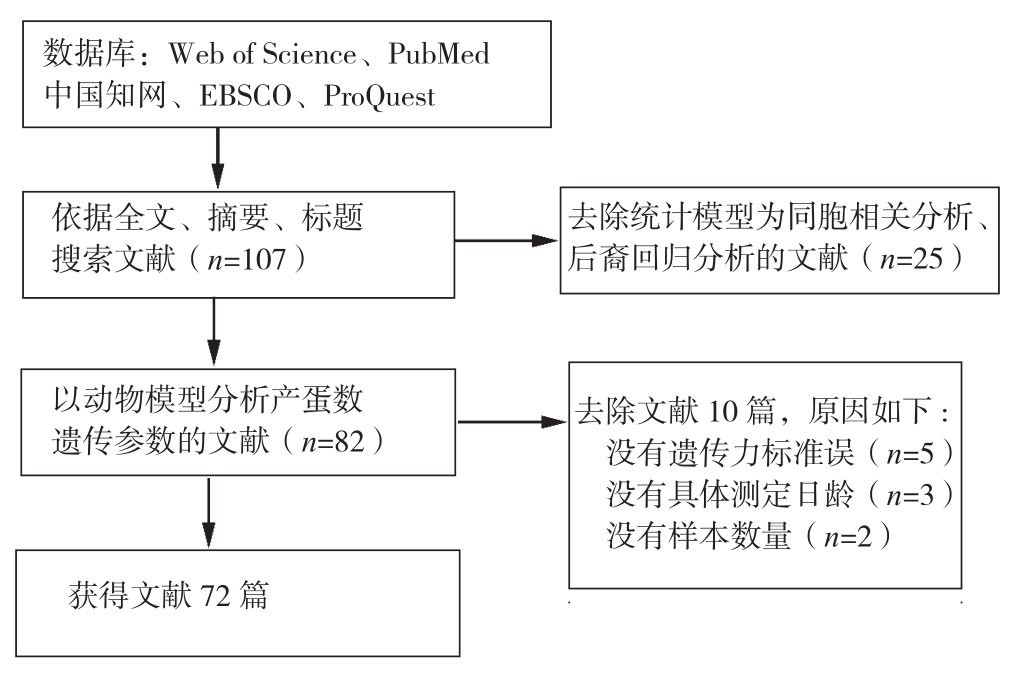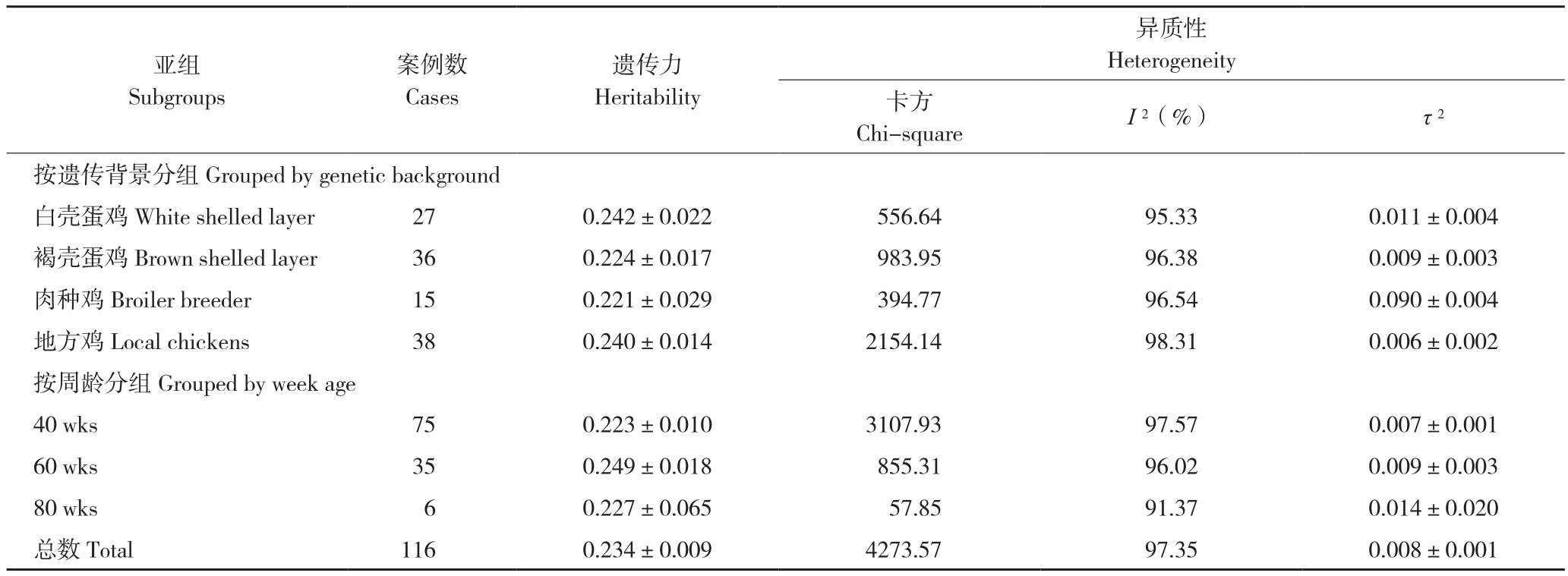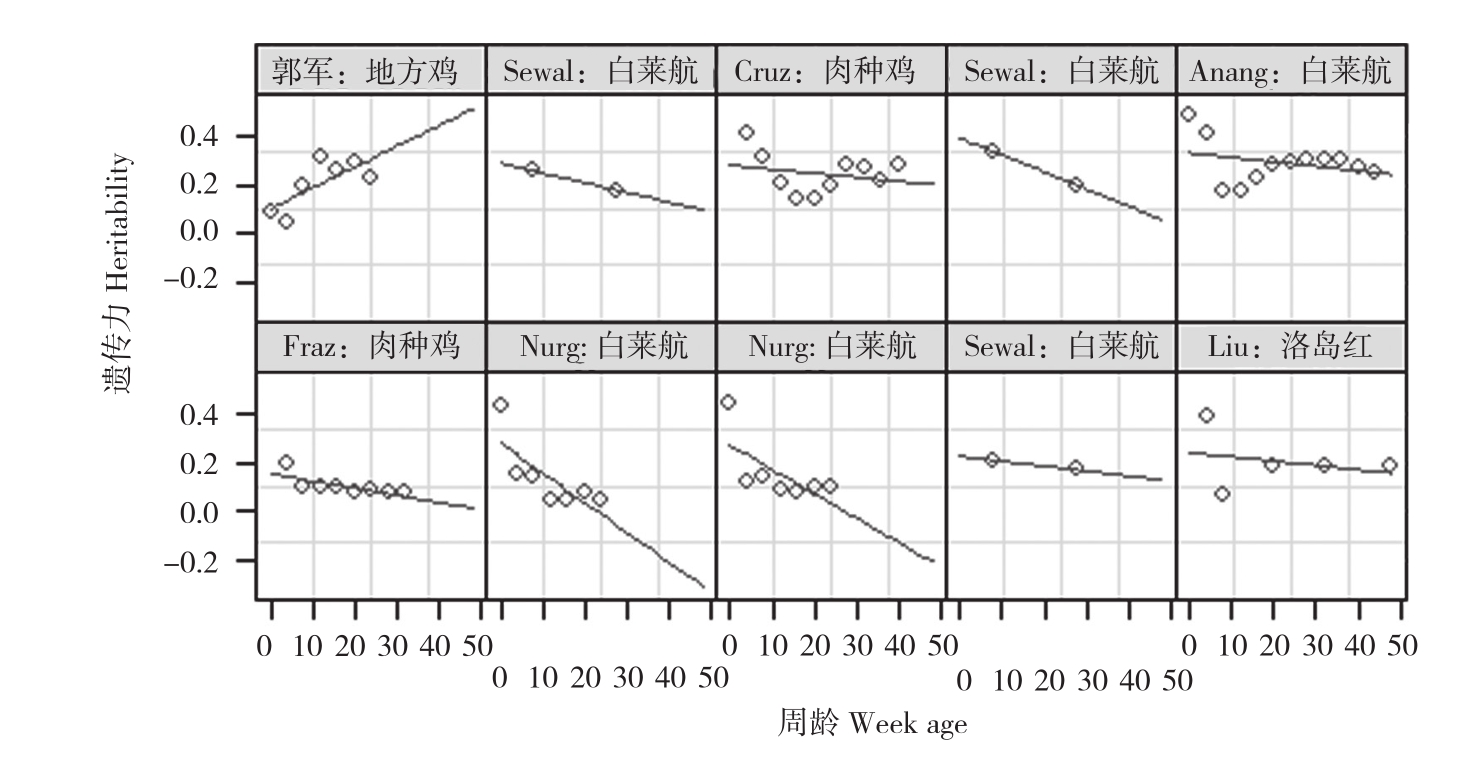【研究意义】Meta分析,也叫荟萃分析、元分析、整合分析,是对具备特定条件的、同课题的诸多研究结果进行综合的一类统计方法[1]。与单个研究结果相比,Meta分析结果更为准确、可靠,可以量化不同研究结果的异质性。当前Meta分析已成为人文科学、社会科学、自然科学领域通用的文献回顾方法。产蛋数是影响蛋鸡养殖收益的关键因素,是蛋鸡育种的主选性状,也是蛋鸡遗传评估的主要研究内容[2]。产蛋数属于数量性状范畴,遗传背景、遗传模型、群体大小、系谱深度、管理水平均可影响其遗传评估结果。现有文献报导的产蛋数遗传力跨度较大,从0.04±0.01[3]到 0.54±0.04[4]不等,使得育种工作者难以选择合适的产蛋数遗传力作为育种规划或指数选择的参数,不利于我国蛋鸡及地方鸡种选育。【前人研究进展】近年有研究报道Meta分析畜禽遗传力的成果。例如,Brito等[5]针对牛、绵羊甲烷排放性状,收集整理了2011—2017年发表的18篇论文,分析加权遗传力估计值。Akanno等[6]以Meta分析技术评估了家猪在热带养殖环境下生殖、生长及屠宰性状的遗传参数。Hradecka等[7]收集整理近40年狗行为相关文献,以随机效应模型估计遗传力。Safari等[8]以Meta分析方法评估分析绵羊生殖、生长等性状遗传参数。Diaz等[9]针对肉牛饲料采食与利用性状,以Meta分析研究50篇论文报告的遗传力数据。Jembere等[10]利用Meta分析山羊繁殖、生长性状遗传力。【本研究切入点】产蛋数属于动态性状,即产蛋期内可以重复测量。有研究以开产至40周龄累计产蛋数为标准计算遗传力,也有研究以产蛋高峰至60周龄累计产蛋数为标准,或以每月产蛋数为标准。统计标准不一致影响遗传力的比较与加权。【拟解决的关键问题】考虑到蛋鸡产蛋数遗传结构的复杂性,通过发掘、利用现有研究结果,我们收集整理产蛋数遗传参数数据并进行Meta分析,初步揭示产蛋数遗传力与年龄变化的关系,为育种工作提供产蛋数遗传力估计值。
1 材料与方法
1.1 文献收集
为收集产蛋数遗传评估文献,通过检索中国知网、ISI Web of Science、PubMed、EBSCO、ProQuest数据库中的会议论文、研究报告和综述,获取蛋鸡、肉种鸡以及地方鸡种的相关数据。Web of Science主题词设定为“egg production”或“egg number”、“heritability”、“chicken”、“-quail”、“-duck”,知网数据库检索主题词设定为“产蛋数”、“遗传力”。由于Besbes等1992年发表的遗传评估文章被认为是家禽首篇利用动物模型进行遗传参数的研究,因此为确保不漏选文献,我们将检索年限提前2年,时限设定为1990年1月到2019年12月,检索不限定语言种类。手工检索标题和摘要,选择符合内控标准的文献,获取全文;对于涉及产蛋数遗传力的综述文章,查找参考文献附录,筛选产蛋数遗传力相关文献。数据采集流程见图1,采集内容包括品种、样本数量、周龄、遗传力平均值、遗传力标准差、统计模型、固定效应、作者、发表年份、期刊、文献标题。
依据品种+周龄统计数据,对于同一群体数据仅采集最后发表的试验结果。产蛋数分为累积产蛋数和动态产蛋数,前者指一次性累加一段时间内的产蛋数,蛋鸡通常统计开产到40周龄产蛋数;后者指每隔一段时间统计产蛋数,因此有多个统计值。两类产蛋数所有遗传模型、生物学意义以及遗传结构存在不同,因此分别统计。
1.2 Meta分析

图1 产蛋数遗传力相关文献采集流程
Fig.1 Selection process of relevant articles on heritability of egg production
应用R语言软件包metafor分析产蛋数遗传力数据[11],以软件包 meta[12]和 ggplot2[13]绘制森林图。为评估研究之间的异质性,进行τ 2、 I 2以及卡方检验。如果I 2<0.5,表示没有显著异质性,可以用固定效应进行合并;如果I 2>0.5,表示研究之间存在显著异质性,可以用随机效应模型进行合并分析[14-15]。Meta分析采用倒方差法确定权重,评估模型可分为固定效应模型和随机效应模型。固定效应模型认为样本来自同一群体,随机效应模型承认研究间存在差异,并以τ 2表示。对于随机效应模型,τ 2分析方法影响参数估计值。医学和心理学研究中多采用DL(DerSimonian-Laird)方法估计τ 2,因为早期Meta分析软件RevMan及Comprehensive Meta-Analysis仅提供DL方法。模拟研究显示REML法、SJ(Sidik-Jonkman)法以及经验贝叶斯方法均好于DL方法[16-17]。本研究采用REML方法估计τ方差。为进一步探寻蛋重遗传力异质性原因,进行亚群分析研究,分别以年龄和遗传背景进行分组。动态产蛋数是同一个体分阶段重复测量,不同时间点获得的遗传力存在相关。如果简单地将不同时间点获得的遗传力看作独立事件,忽略遗传相关,将导致结果出现偏差。本研究应用两步法分析动态产蛋数遗传力[11]。首先利用nlme软件包获得各案例回归系数(截距和斜率)以及方差-协方差矩阵;然后利用metafor软件包生成回归系数向量及相应的方差-协方差矩阵;最后进行多元Meta分析,获得回归方程。
2 结果与分析
2.1 累积产蛋数遗传力
累积产蛋数遗传力较低,研究对象集中在高产蛋鸡,包括白莱航鸡、洛岛红鸡及洛岛白鸡,研究结果集中在开产到40周龄阶段(表1)。亚组分析表明,不同的遗传背景、周龄存在产蛋数遗传力上的异质性;肉种鸡与褐壳蛋鸡的产蛋数遗传力相近,或许与两者遗传背景相似有关。地方鸡亚组内异质性最高,与地方鸡种来源多样有关,研究对象来自东亚、西亚或欧洲。随着周龄增加,累积产蛋数遗传力表现出先升后降趋势,但产蛋后期样本量小、采样时间点分布不足,结论需更多数据支持。此外,根据样本数量进行亚组分析,未发现统计学意义上的差别,故未在表1呈现。由图2可知,白壳蛋鸡产蛋数遗传力最小值为0.09,最大值为0.54。
2.2 动态产蛋数遗传力
如图3所示,动态产蛋数遗传评估多以高产蛋鸡为研究对象。各研究的截距、斜率存在不同,总体呈下降趋势,即产蛋后期遗传力较低。经两步法Meta分析,动态产蛋数遗传力线性回归方程为:
式中,h2为动态产蛋数遗传力,t为产蛋周龄。动态产蛋数遗传力略低于累积产蛋数遗传力。
表1 产蛋数遗传力亚组分析
Table 1 Subgroup analysis on heritability of egg production

异质性Heterogeneity卡方Chi-square I 2(%) τ 2按遗传背景分组Grouped by genetic background白壳蛋鸡White shelled layer 27 0.242±0.022 556.64 95.33 0.011±0.004褐壳蛋鸡Brown shelled layer 36 0.224±0.017 983.95 96.38 0.009±0.003肉种鸡Broiler breeder 15 0.221±0.029 394.77 96.54 0.090±0.004地方鸡Local chickens 38 0.240±0.014 2154.14 98.31 0.006±0.002按周龄分组Grouped by week age 40 wks 75 0.223±0.010 3107.93 97.57 0.007±0.001 60 wks 35 0.249±0.018 855.31 96.02 0.009±0.003 80 wks 6 0.227±0.065 57.85 91.37 0.014±0.020总数Total 116 0.234±0.009 4273.57 97.35 0.008±0.001亚组Subgroups案例数Cases遗传力Heritability

图2 白壳蛋鸡产蛋数遗传力森林图
Fig.2 Forest plot on heritability of egg production of white shelled layer

图3 动态产蛋数遗传力的回归分析
Fig.3 Regression analysis on dynamic heritability of egg production
产蛋周龄自鸡群开产后计算;第一作者与鸡种合并作为研究标签
X-axis represents the week age of egg laying is calculated after the production of first egg.The study-label is the combination of the first author and breed
3 讨论
对于Meta分析,研究异质性阻碍探寻产蛋数遗传力变化规律,但异质性总是与Meta分析相伴,并成为推动遗传力研究的动力。本研究应用Meta分析了116个产蛋数遗传评估结果,以亚组分析和两步法回归分析解析异质性来源。Meta分析结果表明,累积产蛋数加权遗传力为0.23±0.01,与 Yuan 等(0.20±0.04)[18]、Tongsiri等(0.20±0.04)[19]、Cruz等(0.19±0.04)[20]、Jafarnejad 等(0.19±0.05)[21]、Younis 等(0.23±0.09)[22]所得研究结果相近。产蛋数遗传力表明遗传因素可解释23%个体间差异。
本研究应用亚组分析方法从遗传背景、产蛋周龄等多角度分析了遗传力数据,但是异质性依旧停留在高水平,表明遗传背景、产蛋周龄对产蛋数遗传力影响有限,推测群体特异性对产蛋数遗传力有重要影响。Veeramani等[23]以白莱航鸡N品系和P品系为材料,评估结果显示40周龄累积产蛋数遗传力分别为0.31±0.05、0.19±0.04,表明不同品系间遗传力差异显著。Nurgiartiningsih等[24]评估了两个白莱航鸡品系产蛋性能,获得20周龄、44周龄产蛋数遗传力分别为0.09±0.01、0.22±0.02。Gervais等[25]以白莱航鸡蛋壳强度双向选择品系为评估对象,结果表明高选系产蛋数遗传力为0.253±0.032、低选系产蛋数遗传力为0.162±0.028,以上3组评估对象同为白莱航鸡,且排除场效应、免疫程序等环境因素影响,然而品系之间仍存在差异,表明产蛋数遗传力具有群体特异性。
Meta分析结果表明,产蛋数遗传力随着产蛋周龄增加而降低。产蛋后期,蛋鸡生理机能趋于退化,产蛋性能逐渐降低。多个研究团队都曾报道产蛋后期鸡脂肪肝、骨质疏松比率上升,产蛋数减少[26-28],遗传调控功能减弱,产蛋数遗传力下降[3,29-30]。本研究得到了产蛋数遗传力线性回归方程,能为蛋鸡育种及地方鸡种遗传改良提供参考。但因本研究所收集的数据主要集中在产蛋高峰期,即40周龄左右,产蛋后期数据较少。小样本量导致误差增大,表现为80周龄遗传力标准差较大。此外,许多文献未提供产蛋数平均值,无法进行群体对比分析,也无法进行产蛋性能亚组分析,而且受软件限制,回归分析时只能使用线性模型。如图3所示,动态产蛋数遗传力并非线性分布,以非线性模型拟合效果将更好,后续研究将通过更好的软件优化这方面结果。
4 结论
本研究以Meta分析方法研究鸡产蛋数遗传力,应用随机效应模型、亚组分析以及两步法回归分析获得累积产蛋数遗传力及标准差和动态产蛋数遗传力方程。研究结果主要体现在以下3点:(1)鸡累积产蛋数遗传力为0.234±0.009,动态产蛋数遗传力方程为h2=-0.0023t+0.2253;(2)遗传背景影响产蛋数遗传力,选育时应借鉴遗传背景近似的研究结果,最好针对选育群体进行遗传评估;(3)产蛋数遗传力随周龄变化而变化,产蛋后期遗传力较低。
[1]O'ROURKE K.An historical perspective on meta-analysis: dealing quantitatively with varying study results[J].Journal of the Royal Society of Medicine, 2007, 100(12): 579-582.doi:10.1177/01410768 07100012020.
[2]THIRUVENKADAN A, PANNEERSELVAM S, PRABAKARAN R.Layer breeding strategies: an overview[J].World's Poultry Science Journal, 2010, 66(3): 477-502.doi:10.1017/S0043933910000553.
[3]NURGIARTININGSIH V M A, MIELENZ N, PREISINGER R,SCHMUTZ M, SCHÜLER L.Heritabilities and genetic correlations for monthly egg production and egg weight of White Leghorn hens estimated based on hen-housed and survivor production[J].Archivfür Geflügelkunde, 2005, 69: 98-102.
[4]HARTMANN C, STRANDBERG E, RYDHMER L, JOHANSSON K.Genetic relations of yolk proportion and chick weight with production traits in a White Leghorn line[J].British poultry science, 2003, 44(2):186-191.doi:10.1080/0007166031000096489.
[5]BRITO L, SCHENKEL F, OLIVEIRA H, CÁNOVAS A, MIGLIOR F.Meta-analysis of heritability estimates for methane emission indicator traits in cattle and sheep[C].Proceedings of the World Congress on Genetics Applied to Livestock Production, 2018: 740.
[6]AKANNO E, SCHENKEL F, QUINTON V, FRIENDSHIP R,ROBINSON J.Meta-analysis of genetic parameter estimates for reproduction, growth and carcass traits of pigs in the tropics[J].Livestock Science, 2013, 152(2-3): 101-113.doi:10.1016/j.livsci.2012.07.021.
[7]HRADECKA L, BARTOS L, SVOBODOVA I, SALES J.Heritability of behavioural traits in domestic dogs: A meta-analysis[J].Applied Animal Behaviour Science, 2015, 170: 1-13.doi:10.1016/j.applanim.2015.06.006.
[8]SAFARI E, FOGARTY N, GILMOUR A R.A review of genetic parameter estimates for wool, growth, meat and reproduction traits in sheep[J].Livestock Production Science, 2005, 92(3): 271-289.doi:10.1016/j.livprodsci.2004.09.003.
[9]DIAZ I, CREWS D H, ENNS R M.Cluster and meta-analyses of genetic parameters for feed intake traits in growing beef cattle[J].Journal of Animal Breeding and Genetics, 2014, 131(3): 217-226.doi:10.1111/jbg.12063.
[10]JEMBERE T, DESSIE T, RISCHKOWSKY B, KEBEDE K,OKEYO A, HAILE A.Meta-analysis of average estimates of genetic parameters for growth, reproduction and milk production traits in goats[J].Small Ruminant Research, 2017, 153: 71-80.doi:10.1016/j.smallrumres.2017.04.024.
[11]VIECHTBAUER W.Conducting meta-analyses in R with the metafor package[J].Journal of statistical software, 2010, 36(3): 1-48.doi:10.18637/jss.v036.i03.
[12]SCHWARZER G, CARPENTER J R, RÜCKER G.Meta-analysis with R[M].Springer, 2015.
[13]WICKHAM H.ggplot2: elegant graphics for data analysis[M].Springer, 2016.
[14]HIGGINS J P, THOMPSON S G, DEEKS J J, ALTMAN D G.Measuring inconsistency in meta-analyses[J].BMJ, 2003, 327(7414): 557-560.
[15]HIGGINS J P, THOMPSON S G.Quantifying heterogeneity in a metaanalysis[J].Statistics in Medicine, 2002, 21(11): 1539-1558.doi:10.1002/sim.1186.
[16]VIECHTBAUER W.Bias and efficiency of meta-analytic variance estimators in the random-effects model[J].Journal of Educational and Behavioral Statistics, 2005, 30(3): 261-293.doi:10.3102/10769986030003261.
[17]SIDIK K, JONKMAN J N.A comparison of heterogeneity variance estimators in combining results of studies[J].Statistics in medicine,2007, 26(9): 1964-1981.doi:10.1002/sim.2688.
[18]YUAN J, SUN C, DOU T, YI G, QU L, QU L, WANG K, YANG N.Identification of promising mutants associated with egg production traits revealed by genome-wide association study[J].PloS one, 2015, 10(10):e0140615-e0140615.doi:10.1371/journal.pone.0140615.
[19]TONGSIRI S, JEYARUBAN M G, VAN DER WERF J H J.Genetic parameters for egg production traits in purebred and hybrid chicken in a tropical environment[J].British Poultry Science, 2015, 56(6): 613-620.doi:10.1080/00071668.2015.1099614.
[20]CRUZ V, PIRES A, GON A F, TORRES FILHO R A, PEREIRA I G,ARAÚJO C V.Egg production selection in partial and accumulated periods in a commercial broiler line[J].Arquivo Brasileiro de Medicina Veterinária e Zootecnia, 2016, 68(2): 489-96.doi:10.1590/1678-4162-7906.
[21]JAFARNEJAD A, KAMALI M A, FATEMI S J, AMINAFSHAR M.Genetic evaluation of laying traits in iranian indigenous hens using univariate and bivariate animal models[J].Journal of Animal and Plant Sciences 2017, 27(1): 20-27.
[22]YOUNIS H H, ABDEL-GHANY F A, NASRA B A.Genetic improvement of egg production traits in dokki-4 strain 1- correlated responses heritability, genetic and phenotypic correlations for egg production and egg quality traits[J].Egyptian Poultry Science Journal, 2014, 34(1): 345-362.doi:10.21608/epsj.2014.5320.
[23]VEERAMANI P, CHURCHIL R R, KUTTY K N.Estimates of heritability and correlations of economic traits in two strains of white leghorn[J].International Journal of Veterinary Science, 2012(2):45-48.
[24]NURGIARTININGSIH V, MIELENZ N, PREISINGER R, SCHMUTZ M, SCHÜLER L.Correcting group cage records for mortality to utilize more information in predicting breeding values for egg production[J].Archiv für Ge flügelkunde, 2006, 72(2): 68-74.
[25]GERVAIS O, NIRASAWA K, VINCENOT C E, NAGAMINE Y,MORIYA K.Long-term selection using a single trait criterion, nondestructive deformation, in White Leghorns: Effect over time on genetic parameters for traits related to egg production[J].Animal Science Journal, 2017, 88(2): 222-230.doi:10.1111/asj.12653.
[26]REGMI P, NELSON N, STEIBEL J P, ANDERSON K E, Karcher D M.Comparisons of bone properties and keel deformities between strains and housing systems in end-of-lay hens[J].Poultry Science, 2016, 95(10): 2225-2234.doi:10.3382/ps/pew199.
[27]JIANG S, CHENG H W, CUI L Y, ZHOU Z L, HOU J F.Changes of blood parameters associated with bone remodeling following experimentally induced fatty liver disorder in laying hens[J].Poultry Science, 2013, 92(6): 1443-1453.doi:10.3382/ps.2012-02800.
[28]PREISINGER R.Innovative layer genetics to handle global challenges in egg production[J].British Poultry Science, 2018, 59(1):1-6, doi:10.1080/00071668.2018.1401828
[29]ANANG A, MIELENZ N, SCHÜLER L.Genetic and phenotypic parameters for monthly egg production in White Leghorn hens[J].Journal of Animal Breeding and Genetics, 2000, 117(6): 407-415.doi:10.1046/j.1439-0388.2000.00258.x.
[30]FARZIN N, VAEZ TORSHIZI R, GERAMI A, SERAJ A.Estimates of genetic parameters for monthly egg production in a commercial female broiler line using random regression models[J].Livestock Science,2013, 153(1): 33-38.doi:10.1016/j.livsci.2013.01.015.